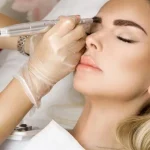Microblading has become a popular beauty trend that offers a semi-permanent solution for fuller, more defined eyebrows. This technique uses a small handheld tool to deposit pigment into the skin, mimicking the appearance of natural eyebrow hairs. While the procedure offers convenience and long-lasting results, it comes with certain guidelines to ensure safety, quality, and the best possible outcome.
In this article, we will discuss the essential rules for microblading that both clients and technicians should follow to ensure a successful and safe experience.
In today’s fast-paced world, beauty routines can be time-consuming, with multiple steps for flawless skin, well-defined brows, and perfect lips. For many, simplifying this daily ritual is a priority. Permanent makeup (PMU) is the revolutionary solution that has been gaining popularity over the years, especially in 2025, offering convenience, cost-effectiveness, and a boost to personal confidence. Let’s explore how this innovative beauty trend can streamline your routine and provide lasting benefits.
What Is Microblading?
Microblading is a form of cosmetic tattooing designed to enhance the appearance of eyebrows. The procedure uses tiny, fine blades to implant pigment into the skin in hair-like strokes, creating a natural look. Unlike traditional eyebrow tattoos, which use a machine for application, microblading involves a manual tool to give a more delicate and natural finish.
The Essential Rules for Microblading
1. Choose a Certified Technician
One of the most important aspects of microblading is selecting a qualified and certified technician. Microblading is a procedure that requires knowledge of the skin, pigments, and the technique itself. A certified technician has undergone proper training and is familiar with the safety guidelines and best practices. Ensure your technician has a valid certification and a portfolio of successful results before scheduling your session.
2. Understand the Healing Process
After your microblading session, your eyebrows will go through a healing process. It typically takes between 4 to 6 weeks for the skin to fully heal and for the pigment to settle in. During this period, it’s important to follow aftercare instructions carefully to avoid infection and ensure the best results. Avoid getting the treated area wet, do not pick at scabs, and apply any prescribed ointment or healing cream to the area.
3. Keep Skin Clean and Moisturized
Following the treatment, maintaining clean skin is crucial. Use a gentle cleanser to keep the area free of dirt and oils. Avoid harsh chemicals or exfoliating products near the eyebrows during the healing process, as they can cause irritation or disrupt the pigment. Keeping your skin moisturized will also aid in healing and help the pigment retain its color.
4. Avoid Sun Exposure
Excessive sun exposure can cause the pigment to fade faster. For the first few weeks after your procedure, make sure to avoid direct sunlight on your eyebrows. Wearing a hat or applying a sunblock specifically designed for tattooed areas is highly recommended to preserve the longevity of your microblading results.
5. Follow Aftercare Instructions
Each technician will provide a personalized aftercare plan. Following these instructions is crucial to avoid complications such as infection or color fading. Some general aftercare tips include avoiding makeup on the brows for at least a week, refraining from excessive sweating, and keeping the area dry and clean.
6. Touch-Ups Are Necessary
Microblading is not a one-time procedure. Over time, the pigment may fade, and your eyebrows may need a touch-up session to refresh the color and maintain the defined look. The need for touch-ups varies depending on skin type, lifestyle, and the quality of aftercare. Most clients return for a touch-up session after 6-12 months.
7. Health Conditions and Contraindications
Before undergoing microblading, it’s essential to disclose any health conditions or medications that may affect the procedure. Individuals with certain conditions, such as eczema, psoriasis, or keloid scarring, may not be suitable candidates for microblading. Pregnant or breastfeeding women are typically advised against this procedure as well. Always consult with your technician about your health history before scheduling your session.
Benefits of Microblading
- Long-lasting results: Microblading offers semi-permanent results, typically lasting between 1 to 3 years.
- Time-saving: Say goodbye to the daily routine of filling in your eyebrows. Microblading saves time on your morning beauty routine.
- Natural appearance: With fine strokes, microblading replicates the look of natural eyebrow hairs, providing a more defined and fuller brow shape.
Possible Risks and Side Effects
While microblading is generally safe, there are some potential risks, such as:
- Infection: If proper aftercare is not followed, there is a risk of infection at the tattoo site.
- Allergic reaction: Some individuals may experience an allergic reaction to the pigments used.
- Uneven results: If the procedure is done improperly, it can result in uneven or unnatural-looking eyebrows.
Conclusion
Microblading is an incredible beauty enhancement that provides lasting, natural-looking results. However, it’s essential to follow the rules and guidelines set by your technician to ensure a safe procedure and long-lasting results. From choosing a certified technician to taking proper care during the healing process, every step plays a vital role in achieving beautiful, well-defined eyebrows. If you are considering microblading, reach out to Beauty Planet – Permanent Makeup to get expert advice and guidance from certified professionals.
For any inquiries, you can reach us at +12015096242 or email beautyplanetpermanent@gmail.com.
FAQ: What Are the Most Common Questions About Microblading?
1. How long does microblading last?
Microblading typically lasts 1 to 3 years, depending on skin type, lifestyle, and aftercare.
2. Is microblading painful?
Most clients report minimal discomfort during the procedure, as a numbing cream is applied beforehand.
3. Can I wear makeup after microblading?
It is recommended to avoid makeup on the treated area for at least a week to ensure proper healing.
4. What should I do if I have an allergic reaction?
If you experience redness, swelling, or itching beyond the normal healing process, contact your technician immediately.
5. How much does microblading cost?
The cost of microblading varies depending on location, technician experience, and other factors, but it typically ranges from $400 to $800.






